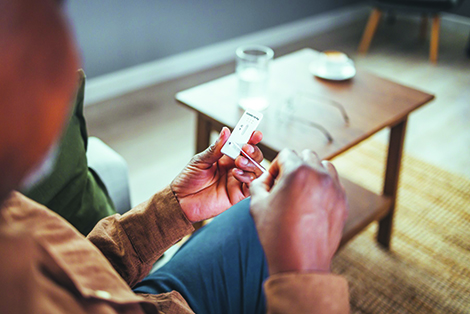
“We’re not out of the woods yet,” said Dr. Albert A. Rizzo, chief medical officer for the American Lung Association. “That’s why it’s so important for those at high risk to understand when to test for the disease and to learn more about available treatment options.”
In response to the evolving science, the American Lung Association, with support from Pfizer, maker of a COVID vaccine, encourages older adults, people living with chronic lung disease, and other high-risk individuals to speak with their healthcare provider about their treatment options if they test positive for COVID-19.
Cold and flu season is upon us, bringing increased cases of infectious respiratory diseases, including flu, respiratory syncytial virus (RSV) and COVID-19. If you experience symptoms that could be COVID-19, get tested right away. Keep in mind that many infectious respiratory illnesses have similar symptoms, so during flu season, it’s especially important to find out which virus you have and which treatment is right for you.
If you’re exposed to COVID-19 but don’t experience symptoms, you should also test at least five days after the exposure. You may also consider getting tested prior to visiting someone at high risk for severe COVID-19 illness.
If you test positive for COVID-19 and are high-risk, speak with your healthcare provider right away about available treatment options.
Treatment may help prevent severe illness and reduce the risk of hospitalization. Depending on your situation, your healthcare provider may prescribe one of the following:
- Oral antiviral medications, which may reduce the spread of COVID-19 throughout the body by stopping the virus from making copies of itself. This medication should be taken as soon as possible after diagnosis and within five days of symptom onset.
- Monoclonal antibody treatment, an IV infusion antiviral medication, can help immune systems fight off the virus by blocking and limiting the amount of virus within the body. This medication should be given as soon as possible, and within seven days of when you started feeling ill.
After treatment, monitor your condition and report any lingering or worsening symptoms to your healthcare provider. If you begin having difficulty breathing or any other symptom indicating severe illness, seek urgent care.
More information about COVID-19 testing (including where and how to be tested) and treatment is available at lung.org/treating-COVID and from local health authorities, such as the Tacoma-Pierce County Health Department (tpchd.org, 253-649-1412) and Seattle-King County Public Health (kingcounty.gov/covid, 206-296-4600)).
Officials for the latter note that people experiencing mild to moderate illness can test themselves at home with test kits that are available free at public libraries. There also are free test sites for the public.
County and the state health departments monitor communicable illnesses, including COVID-19 and flu, and issue weekly updates on their prevalence. The information, which is obtained through hospitals and urgent-care clinics, lab tests, and reports of any outbreaks at congregate settings such as long-term care facilities, are made available online and through the news media.
COVID-19 report a wide range of symptoms, from mild to severe, that may occur two to 14 days after exposure. They include:
- Cough.
- Shortness of breath or difficulty breathing.
- Fever.
- Chills.
- Muscle pain.
- Headache.
- Sore throat.
- Loss of taste or smell.
“While effective treatments can help prevent severe illness after infection, vaccination is still the best protection against COVID-19,” Rizzo said. “Keep your vaccinations up to date. Check with your healthcare provider to see if you’re eligible for an updated booster.”
StatePoint Media contributed to this report.